Latest News
March 3, 2008
By Brett Duesing
Reichel-Pugh Yacht Design, based in San Diego, CA, specializes in designing world-class racing yachts. The company’s designs have won 17 major competitions so far this decade, including nearly every major Grand Prix-level sailing contest on the planet.
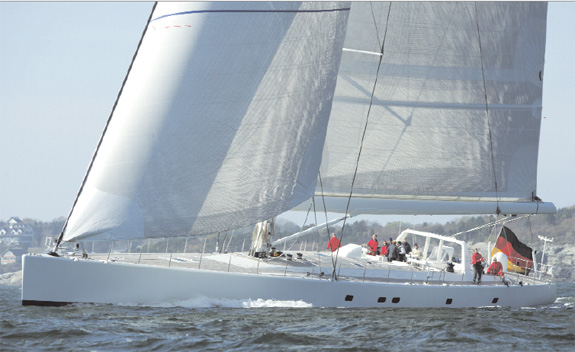 Visione is a 147-foot high-performance cruiser that was designed by Reichel-Pugh using acombination of analysis-based surface modelers and Rhino 3D design software. |
According to John Reichel, principal of Reichel-Pugh, in his 25 years of yacht design, the tools, materials, and building methods have changed at every level. When the graduate of the naval architecture program at the University ofMichigan began his career, he followed the tedious tradition of hand drafting. For example, to describe a hull’s complex curves to builders, Reichel had to draw dozens of cross-sections on paper. “I used to spend most of my time sharpening pencils,” jokes Reichel.
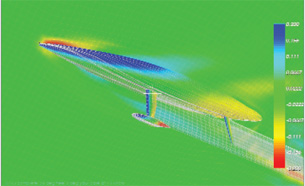 FloSim is a non-linear free surface panel modeler that adds a 3D boundary layer solution to accuratelypredict friction forces on boat hulls. Reichel-Pugh relies on it during the design process. |
Today, the curves of yacht designs are all communicated via 3D computer models. The technology, however, has become more than simply a replacement for drafting. Using simulation, Reichel-Pugh can analyze the effects of loads, winds, and waves to further refine the nuances of performance. Instead of functioning as a mere static drawing, 3D has taken on an active role in yacht construction by virtue of simulation.
Nautical NURBS Adds Accuracy
The Reichel-Pugh team uses surface modelers based on NURBS, which are true mathematical equations of curved surfaces. The modelers can calculate each point on a hull with extreme accuracy. Hull shapes are generated in FastShip, a NURBS modeler from Proteus Engineering that contains specialized templates to create such esoteric nautical objects as bossings, bulbous bows, knuckles, and twin skegs. Other components are modeled in Rhinoceros from McNeel North America.
Because both programs are NURBS-based, the FastShip hull forms are seamlessly imported into Rhino and all boat parts are assembled into a master 3D model. Reichel also uses Rhino to render his final designs as photorealistic examples.
CFD & FEA Improve Performance
The structural loads on a sailboat are dynamic: forces of gravity, drag from the water, and wind resistance fluctuate constantly while the craft is in motion. Because of this, Reichel runs simulations and performance prediction programs to optimize the designs.
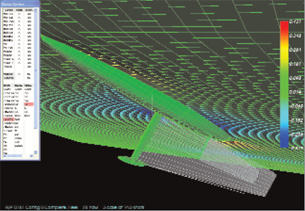 This image shows a FloSim analysis of the water’s surface around the hull and keel of a 60-meterperformance yacht designed by Reichel-PughYacht Design. |
New hull shapes are built as third-scale models and tested in a towing tank to validate computational fluid dynamics (CFD) analyses on the solid models. SPLASH, FloSim, Comet CFD, and Overflow are some of the CFD solvers used by Reichel-Pugh to predict hydrodynamic drag on the hulls and other appendages.
“In addition to the hydrodynamics, structural efficiency is a critical consideration,” explains Reichel. “Lightweight and stiff structures are required to maximize performance.” By applying a battery of finite element analysis (FEA) programs like, NASTRAN, ALGOR, and COSMOS, Reichel-Pugh engineers can assess the structural requirements of the full-scale hull, and adjust designs accordingly.
Oven-Fresh Construction
Once design and testing is completed, the 3D model is sent electronically to Reichel-Pugh’s contracted boat builders around the world. Information that was once transmitted in mailing tubes or thermal faxes is now simply e-mailed.
“Looking back on that era, it all seems so primitive,” says Reichel. “Builders are all now at the level where we give them data electronically, either in 2D or 3D formats. They use the electronic files directly for CNC machines and laser cutters.”
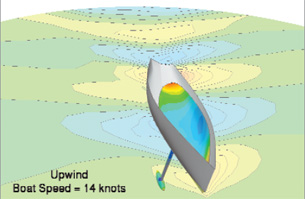 This SPLASH performance analysis of a 60-meter performance cruiser can be adjusted for countlessexamples of different water surfaces, wind speeds, and wind directions. |
“Five or 10 years ago,” Reichel says, “it was not unusual to wet out some dry carbon fiber fabric with hand-mixed epoxy right there on the spot. Now we are using pre-impregnated unidirectional carbon fibers cured at elevated temperatures in ovens.”
The NURBS model, divided into components parts, is converted to the machine language of factory equipment. Laser cutters read the data and can precisely slice out the wooden frames of the hull mold. The wood pieces are assembled, skinned, and coated with epoxy. When finished, the mold resembles a finely crafted boat.
Builders then line the wooden mold with high-tech carbon fabric, core material, and another layer of carbon. “Then you put the boat in the oven,” says Reichel, referring to immense kilns that bake the hulls. “The resin is heat sensitive and cures at the elevated temperature. A vacuum bag covers the entire structure and is used to consolidate the layers during the cure cycle. When the hull comes out a day later, it’s an incredible part.”
Most of the other parts of the yacht — from the carbon decks and interiors to the metal keel fins, carbon rudders, and lead keel bulbs — are also modeled in 3D and cut on CNC machines. The 3D model acts as the invisible hand that guides the entire process of construction.
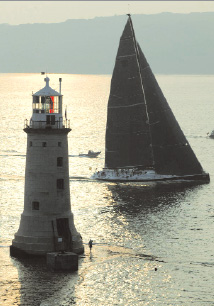 The 90-foot Maxi Rambler rounds thelighthouse on the rock off the south-west tipof Ireland, winning the 2007 Fastnet Race. |
Leisure Craft with An Edge
As a consequence of these new 3D technologies, the schedule of yacht design and construction can proceed more swiftly than ever before. While Reichel spends less time drawing than he did 25 years ago, he can now design in more detail.
“In the past, many of the details were left to the builder,” Reichel says. “With our design capabilities now, all the geometries are defined, and every carbon ply and piece of hardware is specified. Recently, we’ve been moving into the area of high-performance cruising boats, which are very comfortable, but still very high-tech in terms of the systems on board and the materials used for construction.”
With luxury cruisers currently amounting to a quarter of the firm’s output, Reichel-Pugh designers can give their new designs modern styling with the look of traditional sailing yachts; outfitting designs with teak decks and wood veneer interiors. While racing boats are sparse on accommodations, cruisers give occupants the means to traverse oceans with all the comforts of home combined with the structural integrity of racing boats.
Beyond just visible design features, designers use the 3D model to mitigate the overlap of hydraulic systems, computer controlled systems, powered winches, generators, and air conditioning. “Computer modeling gives us the visualization and metrics needed to solve these complex problems,” says Reichel.
In the pursuit of excellence, Reichel-Pugh has adopted performance analysis, digital manufacturing, and the complex detailing of engineering — all made possible through advancements in 3D technology.
More Info:
ALGOR
ALGOR, Inc.
Pittsburgh,PA
algor.com
Comet CFD solver
CD-adapco
London, England
cd-adapco.com
COSMOS
SolidWorks
Concord,MA
cosmosm.com
FastShip
Proteus Engineering
Annapolis,MD
proteusengineering.com
Overflow
NASAAmes ResearchCenter
Moffet Field,CA
nasa.gov
Rhinoceros
McNeel North America
Seattle, WA
rhino3d.com
Reichel-Pugh Yacht Design
San Diego, CA
reichel-pugh.com
SPLASH
South Bay Simulations
Babylon, NY
Subscribe to our FREE magazine, FREE email newsletters or both!
Latest News
About the Author
DE’s editors contribute news and new product announcements to Digital Engineering.
Press releases may be sent to them via [email protected].






